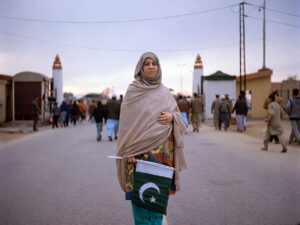For more than 18 years, the Fund for Global Human Rights (the Fund) has catalysed the work of courageous grassroots activists across the globe. Through equipping these bold local leaders with the funding, tools and contacts they need to create transformational change, the Fund has helped millions of people lead lives of dignity with access to basic resources and their fundamental rights. In collaboration with the Fund, Ekow Eshun has gathered together social documentary and portrait photography from Africa, Latin America, South and Southeast Asia for a new exhibition in the King’s Cross Tunnel.
A: The exhibition includes both documentary and portrait photography – depicting agents of change, activists and leaders across the globe. How do the lines blur between these genres? Is it clear-cut or are photographers taking a more hybrid approach?
EE: It’s inevitably a more blurred, hybrid approach. On the one hand you have someone like George Osodi, who spent four years documenting the dramatic effect of oil mining on the lives and lands of people of the Niger Delta. But also, there are a number of photographers in the show who wouldn’t describe themselves as activists. Nevertheless, their images are deeply emphatic portraits of individuals and societies that might otherwise be cast in generic terms. So, the effect of bringing a viewer closer to the individual lives of people in the developing world is a similar one.

A: The photographers cover Africa, Latin America, South Asia and Southeast Asia – huge continents with complex biodiversity and socio-political divides. What themes / subjects do the photographers capture?
EE: They come from quite different perspectives. Dhruv Malhotra is looking at the impacts of urban development on the landscape and people of Noida, a suburban satellite city of New Delhi. Alejandro Cartagena is similarly exploring some of the complex issues relating to unhampered suburban expansion in Mexico. Margaret Courtney-Clarke is exploring the ‘transhumance’ – the search for work, forage and water – in the Namib Desert. And some of the other photographers are concerned with creating a portraiture of dignity and human connection, whether that’s in Kashmir, Lagos or Northern Namibia.

A: Is there an image in particular that has stood out to you, or stayed with you long after viewing?
EE: It is hard to pin it down to one image. Sabelo Mlangeni’s Royal House of Allure images I find deeply compelling, especially James Brown (2019).
A: King’s Cross Tunnel, inherently, holds connotations of journey, from Point A to Point B. How have you displayed the images to tap into this sense of movement – forwards. How will viewers find the images?
EE: The images are presented in a row along the 90m span of the Tunnel along with some contextual texts on the photographer’s work and the exhibition as a whole. The hope is that the succession of images, these depictions of human individuals and experiences, will offer an opportunity for people to engage with parity and connection, at least for a moment, with the lives of others from across the developing world.

Face to Face is organised by the Fund for Global Human Rights, in The King’s Cross Tunnel, 7 October – 1 November. For more information, click here.
Credits:
1. Courtesy of Medina Dugger.
2. Courtesy of Sabelo Mlangeni.
3. Courtesy of Margaret Courtney-Clarke.
4. Courtesy of Kyle Weeks.





